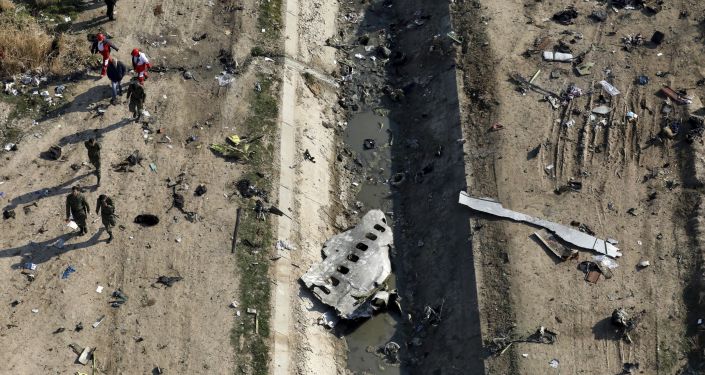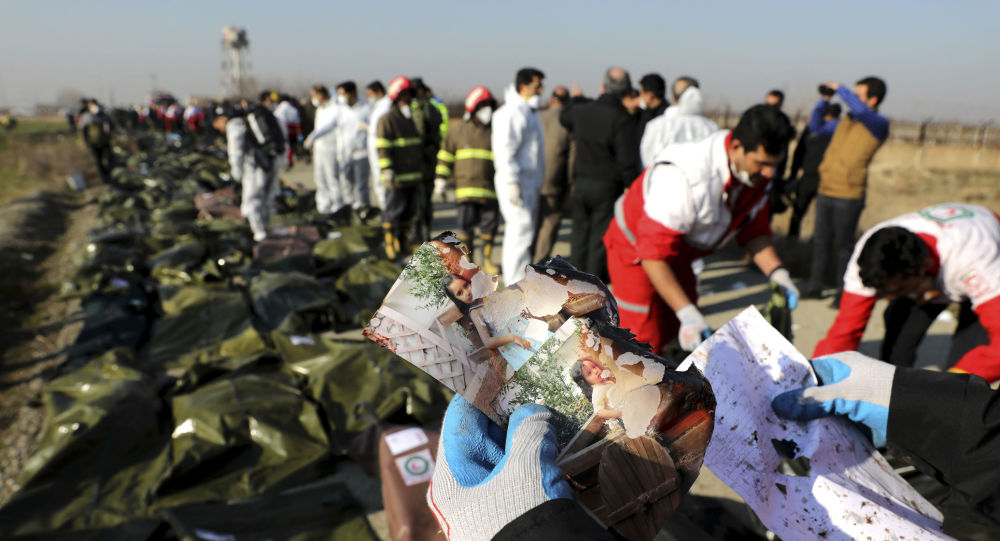Iran Jet Disaster Setup
IN FOCUS, ANGLO AMERICA, BALKANS AND EASTERN EUROPE, MILITARISM, MIDDLE EAST AND NORTH AFRICA, 20 Jan 2020
Soraya Sepahpour-Ulrich and Finian Cunningham | Sputnik – TRANSCEND Media Service
14 Jan 2020 – The 19-second video published by the New York Times last week showing the moment an Iranian missile hit a passenger jet has prompted much social media skepticism.
Questions arise about the improbable timing and circumstances of recording the precise moment when the plane was hit.
The newspaper ran the splash story on January 9, the day after a Ukrainian airliner was brought down near Tehran. It was headlined: ‘Video Shows Ukrainian Plane Being Hit Over Iran’. All 176 people onboard were killed. Two days later, the Iranian military admitted that one of its air defense units had fired at the plane in the mistaken belief that it was an incoming enemy cruise missile.
“A smoking gun” was how NY Times’ journalist Christiaan Triebert described the video in a tweet. Triebert works in the visual investigations team at the paper. In the same tweet, he thanked – “a very big shout out” – to an Iranian national by the name of Nariman Gharib “who provided it [the video] to the NY Times, and the videographer, who would like to remain anonymous”.
The footage i've got from a source – the moment the missile hit the #Flight752. I can't verify the video yet! but please let me know if you find anything. I'm in contact with the person who send this video to see if I can get a version of video which has a meta data on it pic.twitter.com/HtesW5uecB
— me@narimangharib.com (@NarimanGharib) January 9, 2020
The anonymous videographer is the person who caught the 19-second clip which shows a missile striking Flight PS752 shortly after take-off from Tehran’s Imam Khomenei airport at around 6.15 am. This person, who remains silent during the filming while smoking a cigarette (the smoke briefly wafts over the screen), is standing in the suburb of Parand looking northwest. His location was verified by the NY Times using satellite data. The rapid way the newspaper’s technical resources were marshaled raises a curious question about how a seemingly random video submission was afforded such punctilious attention.
But the big question which many people on social media are asking is: why was this “videographer” standing in a derelict industrial area outside Tehran at around six o’clock in the morning with a mobile phone camera training on a fixed angle to the darkened sky? The airliner is barely visible, yet the sky-watching person has the camera pointed and ready to film a most dramatic event, seconds before it happened. That strongly suggests, foreknowledge.
Given that something awful has just been witnessed it is all the more strange that the person holding the camera remains calm and unshaken. There is no audible expression of shock or even the slightest disquiet.
Turns out that Nariman Gharib, the guy who received the video and credited by the NY Times for submitting it, is a vociferous anti-Iranian government dissident who does not live in Iran. He ardently promotes regime change in his social media posts.
Christiaan Triebert, the NY Times’ video expert, who collaborated closely with Gharib to get the story out within hours of the incident, previously worked as a senior investigator at Bellingcat. Bellingcat calls itself an independent online investigative journalism project, but numerous critics accuse it of being a media adjunct to Western military intelligence. Bellingcat has been a big proponent of media narratives smearing the Russian and Syrian governments over the MH17 shoot-down in Ukraine in 2014 and chemical weapons attacks.
In the latest shoot-down of the airliner above Tehran, the tight liaison between a suspiciously placed anonymous videographer on the ground and an expatriate Iranian dissident who then gets the prompt and generous technical attention of the NY Times suggests a level of orchestration, not, as we are led to believe, a random happenstance submission. More sinisterly, the fateful incident was a setup.
It seems reasonable to speculate that in the early hours of January 8 a calamitous incident was contrived to happen. The shoot-down occurred only four hours after Iran attacked two US military bases in Iraq. Those attacks were in revenge for the American drone assassination on January 3 of Iran’s top military commander, Maj. General Qassem Soleimani.
Subsequently, Iranian air-defense systems were on high alert for a possible counter-strike by US forces. Several reports indicate that the Iranian defense radars were detecting warnings of incoming enemy warplanes and cruise missiles on the morning of 8 January. It does seem odd why the Iranian authorities did not cancel all commercial flights out of Tehran during that period. Perhaps because civilian airliners can normally be differentiated by radar and other signals from military objects.
However, with the electronic warfare (EW) technology that the United States has developed in recent years it is entirely feasible for enemy military radars to be “spoofed” by phantom objects. One such EW developed by the Pentagon is Miniature Air-Launched Decoy (MALD) which can create deceptive signals on enemy radar systems of incoming warheads.

Rescue workers search the scene where a Ukrainian plane crashed in Shahedshahr, southwest of the capital Tehran, Iran. © AP Photo / Ebrahim Noroozi
What we contend therefore is this: the Americans exploited a brink-of-war scenario in which they anticipated Iranian air-defense systems to be on a hair-trigger. Add to this tension an assault by electronic warfare on Iranian military radars in which it would be technically feasible to distort a civilian airliner’s data as an offensive target. The Iranian military has claimed this was the nature of the shoot-down error. It seems plausible given the existing electronic warfare used by the Pentagon.
It’s a fair, albeit nefarious, bet that the flight paths out of Tehran were deliberately put in an extremely dangerous position by the malicious assault from American electronic warfare. A guy placed on the ground scoping the outward flight paths – times known by publicly available schedules – would be thus on hand to catch the provoked errant missile shot.
The shoot-down setup would explain why Western intelligence were so quick to confidently assert what happened, contradicting Iran’s initial claims of a technical onboard plane failure.
The disaster has gravely undermined the Iranian government, both at home and around the world. Protests have erupted in Iran denouncing the authorities and the Islamic Revolutionary Guards Corp for “lying” about the crash. Most of the 176 victims were Iranian nationals. The anger on the streets is being fueled by the public comments of Western leaders like Donald Trump, who no doubt see the clamor and recriminations as an opportunity to push harder for regime change in Iran.
________________________________________________
Soraya Sepahpour-Ulrich is an independent researcher and writer with a focus on U.S. foreign policy.
 Finian Cunningham, originally from Belfast, Ireland is a prominent expert in international affairs. The author and media commentator was expelled from Bahrain in June 2011 for his critical journalism in which he highlighted human rights violations by the Western-backed regime. For many years, he worked as an editor and writer in the mainstream news media, including The Mirror, Irish Times and Independent. He is now based in East Africa where he is writing a book on Bahrain and the Arab Spring.
Finian Cunningham, originally from Belfast, Ireland is a prominent expert in international affairs. The author and media commentator was expelled from Bahrain in June 2011 for his critical journalism in which he highlighted human rights violations by the Western-backed regime. For many years, he worked as an editor and writer in the mainstream news media, including The Mirror, Irish Times and Independent. He is now based in East Africa where he is writing a book on Bahrain and the Arab Spring.
Go to Original – sputniknews.com
Tags: Conflict, Geopolitics, Hegemony, History, Imperialism, International Relations, Iran, Israel, Middle East, Politics, Power, Targeted Assassination, Trump, US Military, USA, Violence, War, West
DISCLAIMER: The statements, views and opinions expressed in pieces republished here are solely those of the authors and do not necessarily represent those of TMS. In accordance with title 17 U.S.C. section 107, this material is distributed without profit to those who have expressed a prior interest in receiving the included information for research and educational purposes. TMS has no affiliation whatsoever with the originator of this article nor is TMS endorsed or sponsored by the originator. “GO TO ORIGINAL” links are provided as a convenience to our readers and allow for verification of authenticity. However, as originating pages are often updated by their originating host sites, the versions posted may not match the versions our readers view when clicking the “GO TO ORIGINAL” links. This site contains copyrighted material the use of which has not always been specifically authorized by the copyright owner. We are making such material available in our efforts to advance understanding of environmental, political, human rights, economic, democracy, scientific, and social justice issues, etc. We believe this constitutes a ‘fair use’ of any such copyrighted material as provided for in section 107 of the US Copyright Law. In accordance with Title 17 U.S.C. Section 107, the material on this site is distributed without profit to those who have expressed a prior interest in receiving the included information for research and educational purposes. For more information go to: http://www.law.cornell.edu/uscode/17/107.shtml. If you wish to use copyrighted material from this site for purposes of your own that go beyond ‘fair use’, you must obtain permission from the copyright owner.
One Response to “Iran Jet Disaster Setup”
Read more
Click here to go to the current weekly digest or pick another article:
IN FOCUS:
- Russophobia by the Collective West Opens the Doors for Cold War 2.0
- Rogue States: The illegality of the U.S.-backed Israeli Attacks on Iran
- The Evolution of Leftist and Liberal Ideas from the 18th Century to Today
ANGLO AMERICA:
- Trump, Epstein and the Deep State
- 'An Arsenal of Profiteering': Military Contractors Have Gotten Over Half of Pentagon Spending Since 2020
- Imperial Hypocrisy about “Terrorism” Hits Its Most Absurd Point Yet
BALKANS AND EASTERN EUROPE:
- Serbia’s Organized Chaos
- Popular Revolt Looming in Ukraine? Zelensky’s Battle Over Death Numbers Speaks for Itself
- Forced Recruitment Causing Serious Problems in Ukrainian Society
MILITARISM:
- The Transatlantic Split Myth: How U.S.-Europe Militarization Thrives behind the Rhetoric
- Mapping Militarism 2025
- The Limitations of Military Might
MIDDLE EAST AND NORTH AFRICA:


It is not possible for a videographer unaware of what was going to happen, to zoom his camera seconds before the incident to the exact location in the dark sky. Obviously, the person who took that video knew what was going to happen, its exact time, and exact location. This is a set-up and is hard to believe that the military forces in Iran shot the plane because if they did, how the videographer on the ground whose video was published by the Western media shortly after it was taken, knew about it? A few days before this crash, Hassan Rouhani had reminded the world about the shooting of another airliner over the Persian Gulf some years ago. It seems there is a coup against the Iranian military forces orchestrated by some clerics inside the country with collaboration of the West from the outside.